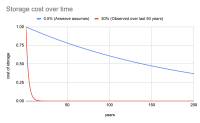Arweave vs IPFS & Filecoin
We examine the two of the biggest decentralized storage protocols and their many differences.
 7 min
7 minStoring digital assets like NFTs, data archiving and legal documents can be a daunting task. The risk and pain of losing valuable files can cost time, money and reputation.
In this article, we will discuss the similarities and differences between Arweave and IPFS, and help you decide which is the best for your project.
What is Arweave?
Arweave is a decentralized blockchain protocol of storage nodes, designed to secure and host your data permanently on-chain.
You make a one-time, upfront payment to store your data, guaranteeing at least 200 years of storage. There are no ongoing monthly maintenance fees, no retrieval fees (egress fees) or hidden charges for using your data, and guaranteed permanence and immutability. Unlike cloud services, where if payments stop, your data is inaccessible and likely lost.
On average, the cost of storage has declined by 30% per year over the past 50 years. Arweave uses a highly conservative estimate of just a 0.5% annual decline when calculating data upload costs. Such a cautious approach ensures the sustainability of Arweave’s economic model while also accounting for the price volatility in the value of $AR.

Arweave is an ideal solution for long-term data preservation projects, including NFT storage and archival.
To start uploading and managing your data on Arweave, you can use Akord.
 What is Akord?
What is Akord?
Akord is a web3 platform offering digital vaults for storing NFT assets on the Arweave blockchain. An intuitive web app, API, SDK and CLI provide the tools for anyone, regardless of their technical experience, to upload to Arweave in a few minutes. Akord is the only Arweave project to offer free storage – 100 MB upon sign up.
On Akord, public vaults are ideal for storing tradable assets such as NFTs and building public archives. In contrast, private vaults are end-to-end encrypted and can be used with token-gated access.
We built Akord as a user-friendly interface that simplifies uploading and managing your data on Arweave. So, even if Akord (the company) ceases to exist, your data uploaded through our service will still be safe and accessible.
If you’re interested in permanent storage on Arweave, you can pay as you go. We offer Akord subscription plans for additional features, like cloud storage, token-gated access, and a significant discount on your Arweave data fees. For instance, Akord charges $12 per GB.Akord subscribers save 25% and pay only $9 per GB. You can cancel your subscription at any time. Your Arweave data is still permanently accessible and owned by you.
What are IPFS & Filecoin?
The InterPlanetary File System (IPFS) developed by Protocol Labs is “a distributed system for storing and accessing files, websites, applications and data”. It aims to make the distributed web more efficient, decentralized and resilient.
IPFS is not a storage solution. Data remains available on the network only as long as at least one individual actively stores it. IPFS employs content addressing to identify files by their contents, enabling access from any host globally without reliance on a centralized entity.
One limitation of IPFS is the lack of an incentive model for users to store and maintain data belonging to others. This gap led Protocol Labs to develop Filecoin, a complementary protocol built on IPFS.
This is where Filecoin comes in. Adding a financial incentive for users to rent out the extra space on their hard drives and creating a decentralized storage marketplace.
Arweave vs. IPFS & Filecoin
Type of storage
Arweave offers permanent storage, while Filecoin offers contract-based storage.
On Arweave, you pay a one-time upfront fee to permanently store your data. Once uploaded, it will never be deleted, and there are no hidden charges (egress fees) for when you need to retrieve and use your data. Arweave guarantees multiple backed-up redundancies within the cost.
Filecoin offers contract-based storage. Users deal with storage providers (SPs) on the amount of data to be stored, the number of replicas, the duration, and the price for storage and data retrieval.
It's important to note that with Filecoin, while you have the option to set an indefinite expiration date for your storage deals, this is contingent on maintaining funds in the contract account. If these funds run out or the deal expires, storage providers (SPs) will stop storing your data, potentially leading to the loss of your valuable data. This highlights the need for careful management of your storage deals.
Cost of storage
Filecoin estimates costs to be around $0.0023 per GB per year. Third-party pinning services like Pinata charge significantly more; the cost is $0.48 per GB per year based on their current plans. While pinning services offer a simpler solution, they introduce additional costs and carry third-party risks such as ceasing operations.
In contrast, Arweave charges a one-time upfront fee of approximately $18 per GB, about $0.09 per GB per year (stored for at least 200 years). Once data is on-chain, it can be accessed at any time without any additional fees, providing significant cost advantages for long-term storage.
Arweave also ensures ample data redundancy, storing at least 20 copies (RAID 20) of each piece of data. On Filecoin, pinning services only replicate data 3-6 times, and increasing redundancy incurs additional costs. This lower replication rate could compromise data availability and security over time.
User experience
To get started with Arweave, follow these steps and have your files permanently stored for life:
1. Create an Akord account and claim your 100MB free storage
2. Create a private vault
3. Drag and drop files into your vault
Unlike Filecoin, Arweave offers a straightforward and reliable solution for your file storage needs. With Filecoin, the setup process can be complex and overwhelming, requiring users to consider numerous variables and third parties when storing their data.
While users may opt for pinning services to simplify the process, these services carry similar risks to centralized companies. Can you rely on these services to store your data safely? Pinning companies like Estuary and alwaysnft.cloud have shut down, proving how unreliable they can be.

Using pinning services can also drive costs up to levels comparable to traditional cloud storage providers, negating Filecoin’s affordability.
Lifecycle of a file
On Arweave, you pay once to store your data indefinitely, ensuring its permanence.
Data on IPFS must be pinned to ensure it isn’t deleted during garbage collection. However, even with pinning, the average lifecycle of data on Filecoin is limited—typically 361 days or 475 days based on the type of storage deal.

So, what happens if you forget to renew your deal, run out of funds, or the pinning service you rely on ceases operations? Each scenario introduces risk and threatens the accessibility and security of your data.
Decentralization
Filecoin currently has 2,719 active storage nodes, while Arweave has 207 estimated storage nodes. While assessing this comparison, however, it's essential to consider where and how your data is stored.
If you choose Filecoin, your data will be stored on the nodes of your selected storage provider throughout the deal, typically involving 3 to 6 nodes, depending on the service used, which means your data is limited to a handful of points, which could become a vulnerability if any of these nodes fail or exit the network.
Arweave’s structure incentivizes each node in its network to store your data. This approach not only enhances decentralization but also significantly increases data resilience. Such redundancy is crucial for ensuring data permanence for entities like NFT collections, digital archives, legal record keepers, and cultural institutions - all of whom rely on long-term accessibility and security of their data.
Is Filecoin sustainable?
Filecoin introduced the 'Filecoin Plus' (Fil+) incentive program to verify customers and subsidize their storage fees, making it a "free" service. Fil+ subsidizes storage fees by paying miners 10x the block reward for storing verified client data.
Of the 1.782 EiB of data stored on the Filecoin network, 99% is subsidized by Fil+. It’s not clear how sustainable this will be in the long-term.
Filecoin was built as an incentive layer for IPFS. Judging by these statistics, it seems that Fil+ is the incentive layer for the incentive layer (Filecoin).
This significant reliance on the Fil+ program underscores a dependency on Filecoin's own subsidies, raising important questions about the protocol's sustainability and real-world appeal.
Without the 'free' services, is there genuine user adoption or demand for Filecoin's services? The allure of 'free' is compelling for users, but its absence may reveal a different market demand, adding an element of uncertainty to the equation.
If users are not paying to store their data, do they genuinely own it?
Ultimately, if the Fil+ incentive program ends, users must start paying for storage that they’ve been used to getting for ‘free’. This could lead to miners raising storage fees to maintain profitability. Faced with these potential changes, will users still use Filecoin or store their data elsewhere? The consequences of these decisions are significant and could greatly impact Filecoin's long-term viability and its ability to retain a user base.
Tokenomics
Both projects have a native currency, used for transaction fees and rewards; Filecoin has the FIL token, and Arweave has the AR token.
Just looking at a token's value provides an incomplete picture. That’s why it’s crucial to understand each protocol's tokenomics. Tokenomics essentially determines the economic value of each project based on the supply and demand for the protocol’s token.
It’s important to consider three factors: circulating supply, maximum supply and whether the protocol has a burn mechanism.
 Burn Mechanism
Burn Mechanism
A burn mechanism permanently takes tokens out of circulation. As this decreases the supply of the token, acting as a deflationary measure, it is expected to lead to an increase in the value of the token.
Currently, Filecoin has 579 million FIL in circulation with a maximum supply of 2 billion FIL that can be issued. Filecoin also has a burn mechanism in which a portion of tokens are burnt through transaction fees on the network or through penalties. To date, around 39 million FIL have been burnt.
Arweave has around 65.7 million AR tokens in circulation with a maximum supply of 66 million AR that can be issued.
From these numbers, we can see two things. Firstly, Filecoin’s maximum supply is 30x Arweave’s maximum supply. Secondly, Arweave already has around 99% of its supply in circulation, while Filecoin only has 28% of its supply in circulation. These two distinctions imply that Filecoin’s supply will cause a lot more downward pressure on its price over time, in comparison to Arweave. Arweave’s tokenomics are more sustainable.
While Arweave does not have a built-in burn mechanism, its storage endowment has a similar effect.
The cost of storage has declined by an average of 30% per year over the past 50 years. Adopting a highly conservative approach, Arweave assumes a mere 0.5% annual decline when calculating data upload costs, ensuring the longevity of its endowment funds.
If Arweave stores less than 20 backup copies of your data, the endowment initiates payouts to incentivise miners to store more replicas and make the market more attractive for other miners to join the network. Since its inception in 2018, no tokens have been withdrawn from the endowment, which confirms the protocol’s efficacy in maintaining this threshold up to this point.
As the tokens in the endowment will be gradually unlocked over a period of at least 200 years, it is reasonable to assume that these tokens are currently not part of the circulating supply.
To learn more about the endowment, read our article here.
Mining rewards
Both networks also allocated portions of their token supply as mining rewards to encourage miners to join their networks.
Filecoin set aside a substantial 1.4 billion $FIL tokens, 70% of its maximum supply, as mining rewards. This allocation supports programs like Fil+, which enables storage providers to earn ten times the block reward for storing verified clients' data compared to regular storage deals.
While this model benefits both clients, who can store data at minimal or no cost, and storage providers, who earn higher rewards for storing verified clients' data, it raises concerns about the genuine demand for storage on the Filecoin network without such incentives.
It’s important to note that the client verification process required to join the Filecoin Plus (Fil+) program effectively creates restricted and centralized access to the network. This approach contradicts Filecoin’s vision of a truly decentralized storage market.
Arweave set aside 11 million $AR tokens, which constitute 17% of its maximum supply, for mining incentives. So far, 10,730,000 tokens have been distributed, with only 270,000 $AR tokens remaining. As the reserve of mining rewards diminishes, miners increasingly turn to data upload fees as a stable source of income.
The sustained commitment of miners to operate with diminishing mining rewards reflects their trust in an economic model where earnings are directly correlated with network activity.
On Arweave’s blockweave, each block is linked not only to the previous and subsequent blocks but also to a randomly chosen past data chunk. This design requires miners to access these random blocks to add new data, incentivizing them to store the entire blockweave.
As a result, miners are compelled to maintain comprehensive data availability, ensuring they can continue to mine new blocks and earn upload fees.
This system fosters a self-sustaining loop where the value and security of the network grow in tandem with its use.
What works best for you?
While Filecoin operates a decentralized storage market with a pay-as-you-go model, similar to traditional cloud storage providers, its reliance on subsidy incentives such as the Fil+ program raises concerns about Filecoin’s long-term viability and centralization.
Arweave stands out by offering up-front and predictable costs, permanent storage, guaranteed for two human lifetimes, and always accessible without additional fees or the risk of data loss due to expired contracts or depleted funds.
Arweave’s approach simplifies the storage process and aligns with the needs of users seeking absolute certainty in data preservation—be it for digital art, legal documents, or historical archives.
If you're looking for a permanent, worry-free storage solution, we highly recommend using Arweave and Akord.
Make your first upload to Arweave for free
Upload public or private data to Akord’s digital vaults. The only app to provide free storage on the Arweave blockchain.



